*NURSING > TEST BANK > NURS 340 Origin: Chapter 21, Questions and Answers and Rationale,100% CORRECT (All)
NURS 340 Origin: Chapter 21, Questions and Answers and Rationale,100% CORRECT
Document Content and Description Below
NURS 340 Origin: Chapter 21, Questions and Answers and Rationale 1. The nurse is caring for a child who is experiencing an acute renal transplant rejection and is to receive muromonab-CD3. What would... the nurse most likely expect to assess after the first dose is administered? A) Fever with chills, chest tightness B) Cough, hyperkalemia C) Photosensitivity, gastrointestinal (GI) upset D) Urinary retention, decreased appetite Ans: A Feedback: The first dose of muromonab-CD3 can cause fever, chills, chest tightness, wheezing, nausea, and vomiting. Cough and hyperkalemia are associated with angiotensin- converting enzyme inhibitors. Photosensitivity and GI upset are often associated with diuretics. Urinary retention and decreased appetite are associated with imipramine. Origin: Chapter 21, 2 2. The nurse is visually inspecting a urine specimen from a 12-year-old boy. The nurse documents gross hematuria with a specimen of which color? A) Cloudy yellow B) Cola colored C) Pale to almost clear urine D) Light orange to moderately yellow colored Ans: B Feedback: Gross hematuria causes the urine to appear tea, cola, or even dirty green colored. Cloudy urine is typically a sign of infection. Normal urine ranges from moderately yellow to pale or almost clear. Orange-colored urine can occur because of medication. Origin: Chapter 21, 3 3. The nurse is caring for a 4-year-old with a suspected urinary tract infection. What would be most appropriate when obtaining a urine specimen from the child? A) "I will need a urine sample." B) "Let your mom help you tinkle in this cup." C) "Please tinkle in this cup right now." D) "Please void in this cup instead of the toilet." Ans: B Feedback: The nurse needs to use familiar terms to explain to the child what is needed and to gain cooperation. The most positive approach would be to let the child's mother help rather than demanding that he tinkle right now. Using the terms "urine sample" or "void" is not appropriate for a 4-year-old. Origin: Chapter 21, 4 4. The nurse is providing postsurgical care for an infant who has undergone a hypospadias repair. Which action by the nurse would be most important to help keep the area clean while maintaining proper position of the drainage tubing? A) Keeping the drainage tube taped in an upright position B) Administering antibiotics as ordered C) Administering analgesics as prescribed D) Using a double-diapering technique Ans: D Feedback: Double diapering is a method used to protect a child's urethra and stent or catheter after surgery and additionally helps to keep the area clean and free from infection. Keeping the drainage tube taped in an upright position, administering antibiotics, and administering analgesics are also important, but double diapering keeps the area clean and helps prevent infection. Origin: Chapter 21, 5 5. The nurse is caring for an infant with bladder exstrophy. As part of the infant's preoperative plan of care, the nurse monitors for abdominal skin excoriation. Which action would be most appropriate for promoting healing and preventing further skin breakdown? A) Cleaning the area well with a scented diaper wipe B) Applying a barrier/healing cream or paste on skin C) Keeping the bladder moist and covered with a sterile bag D) Covering the area with sterile gauze pads after tub baths Ans: B Feedback: The nurse should use a barrier/healing cream or paste on surrounding skin to promote healing and prevent further skin breakdown. Diaper wipes that contain fragrance or alcohol can sting if used on nonintact skin and can worsen skin breakdown. It is important to protect the bladder, but this will not address the skin excoriation. Meticulous attention to cleanliness is important, but the nurse should sponge-bathe the infant rather than immerse him in water to prevent pathogens from the water possibly entering the bladder. Origin: Chapter 21, 6 6. The nurse is caring for a 4-year-old girl with vulvovaginitis. After explaining to the girl's mother how to help prevent subsequent episodes, which statement by the mother indicates a need for additional teaching? A) "She needs to wipe from front to back." B) "I will make sure she changes her underwear every day." C) "She should probably avoid bubble baths." D) "I will help supervise her wiping after bowel movements." Ans: A Feedback: At the age of 4, the mother should not assume that the girl will wipe properly. The mother will need to supervise her wiping in order to train her properly. Making sure the child changes her underwear daily, avoiding bubble baths, and supervising her wiping after bowel movements indicate that the mother has understood the instructions. Origin: Chapter 21, 7 7.A nurse is caring for a 7-year-old girl scheduled for an intravenous pyelogram (IVP). Which action would be the priority before the test? A) Checking with the parents for any allergies B) Ensuring adequate hydration C) Giving the girl an enema D) Screening her for pregnancy Ans: A Feedback: It is important to double-check whether the girl has any allergies. The test is contraindicated in children allergic to shellfish or iodine. Adequate hydration is also important, but the check for allergies is a priority. Only females of reproductive age must be screened for pregnancy. An enema is not necessary at all institutions. Origin: Chapter 21, 8 8.A 6-year-old child has undergone a renal transplant and is receiving cyclosporine. The nurse instructs the parents to be especially alert for which complication? A) Weight loss B) Hypotension C) Signs of infection D) Hair loss Ans: C Feedback: The parents should be especially alert for signs of infection as cyclosporine is an immunosuppressant drug. Weight gain instead of weight loss, hypertension instead of hypotension, and increased facial hair instead of hair loss are some other potential side effects. Origin: Chapter 21, 9 9. The nurse is taking a health history of a child with suspected acute poststreptococcal glomerulonephritis. Which response would alert the nurse to a confirmed risk factor for this condition? A) "She has been very healthy up to now." B) "He just got over a head cold with laryngitis." C) "My child is just 18 months old." D) "My child has not been sick at all." Ans: B Feedback: Known risk factors include a recent episode of pharyngitis or other streptococcal infection, age older than 2 years, and male sex. Origin: Chapter 21, 10 10. The nurse is caring for a 12-year-old girl with nephrotic syndrome. The girl confides that she feels like a "freak" compared to her peers because of her weight, edema, and moon face. Which response by the nurse would be most appropriate? A) "Let's put you in touch with some other girls who are also having the same body changes." B) "Luckily, this is just a temporary, unfortunate part of your condition; you need to accept it." C) "Your real friends do not care about your appearance and just want you to get well." D) "You are beautiful in your own way; what matters is what is on the inside." Ans: A Feedback: It is important to introduce the girl to other youngsters with chronic renal conditions so she does not feel so isolated. Adolescents need interaction with peers. Telling the girl that this is a temporary condition, her real friends don't care about her appearance, and she is beautiful in her own way dismisses the girl's concerns and does not offer solutions. Nephrotic syndrome is a chronic condition, so telling her the condition is temporary also is inaccurate. Origin: Chapter 21, 11 11. An 8-year-old girl is scheduled for a renal ultrasound. What would the nurse include in the plan of care when preparing the child for this test? A) Withholding food and fluids after midnight B) Checking the child for allergies to shellfish C) Ensuring the child has a full bladder D) Informing the child she should feel no discomfort Ans: D Feedback: The nurse should inform the child that she should feel no discomfort during the test. No fasting is required and no dye is used, so allergies are not a concern. A full bladder is needed for urodynamic studies. Origin: Chapter 21, 12 12. The nurse is preparing a teaching plan for the parents of a child with a urinary tract infection (UTI). What would the nurse encourage the parents to avoid? A) Liberal fluid intake B) Caffeine C) Cranberry juice D) Cotton underwear Ans: B Feedback: Caffeine is an irritant to the bladder and should be avoided. Liberal fluid intake and cranberry juice should be encouraged. The child should wear cotton underwear to avoid perineal irritation. Origin: Chapter 21, 13 13. The mother of a child with end-stage renal disease asks the nurse why her son is getting an injection of erythropoietin. When responding to the mother, the nurse explains this as the rationale. A) To treat low calcium levels B) To stimulate growth in stature C) To stimulate red blood cell growth D) To correct acidosis Ans: C Feedback: Erythropoietin is given to stimulate red blood cell growth. Vitamin D and calcium are used to correct hypocalcemia. Growth hormone is used to stimulate growth in stature. Bicitra or sodium bicarbonate tablets are used to correct acidosis. Origin: Chapter 21, 14 14.A child is diagnosed with hemolytic-uremic syndrome (HUS). Review of the child's laboratory test results would reveal which finding? A) Decreased blood urea nitrogen (BUN) and creatinine B) Decreased platelets and leukocytosis C) Hypernatremia and hypokalemia D) Respiratory acidosis and proteinuria Ans: B Feedback: The child with HUS typically exhibits severe thrombocytopenia (decreased platelets) and leukocytosis. BUN and creatinine are elevated. Hyponatremia, hyperkalemia, metabolic acidosis, and proteinuria also may be noted. Origin: Chapter 21, 15 15.After teaching the parents of a child with a hydrocele about this condition, which statement indicates that the teaching was successful? A) "If this gets worse and we don't treat it, our son could become infertile." B) "This condition should gradually go away on its own." C) "The surgeon is going to operate on him immediately." D) "It's going to be difficult putting ice packs on his scrotum." Ans: B Feedback: Hydrocele requires watchful waiting because it will usually resolve spontaneously on its own. Hydrocele is not associated with the development of infertility; a varicocele, if left untreated, can lead to infertility. Immediate surgery is warranted for testicular torsion. Ice packs to the scrotum are helpful in relieving pain associated with epididymitis. Origin: Chapter 21, 16 16.A nurse is conducting a physical examination of an infant and observes the urethral opening on the dorsal side of the penis. The nurse documents this finding as: A) hypospadias. B) epispadias. C) varicocele. D) hydrocele. Ans: B Feedback: Epispadias is a urethral defect in which the opening is on the dorsal surface of the penis. Hypospadias is a urethral defect in which the opening is on the ventral surface of the penis rather than at the end. Varicocele is a venous varicosity along the spermatic cord manifested as a scrotal swelling. Hydrocele is a benign condition in which fluid accumulates in the scrotal sac. Origin: Chapter 21, 17 17.A 15-year-old boy comes to the emergency department accompanied by his parents. The boy reports an abrupt onset of sudden pain on the right side of his scrotum. When asked to rate his pain on a scale of 1 to 10, with 10 being the most severe, the boy states, "It's a 12." Further assessment reveals a blue-black swelling on the affected side. The nurse suspects testicular torsion and immediately notifies the physician because: A) the condition is a surgical emergency. B) the boy is at risk for sepsis. C) intravenous antibiotics need to be initiated. D) renal failure is imminent. Ans: A Feedback: Testicular torsion is a surgical emergency that necessitates immediate surgical correction to prevent testicular necrosis and possible gangrene. There is no infection with testicular torsion, intravenous antibiotics are not used to treat this condition, and renal failure is not imminent. Origin: Chapter 21, 18 18. The nurse is reviewing the laboratory test results of a child with nephrotic syndrome. What would the nurse least likely expect to find? A) Hyperlipidemia B) Hypoalbuminemia C) Decreased blood urea nitrogen (BUN) D) Hypoproteinemia Ans: C Feedback: With nephrotic syndrome, proteinuria, hyperlipidemia, decreased serum protein levels (hypoproteinemia), and decreased serum albumin levels (hypoalbuminemia) are present. BUN typically becomes elevated. Origin: Chapter 21, 19 19. The nurse is applying a urine bag to a 15-month-old boy to collect a urine specimen. Which action would the nurse take first? A) Apply benzoin to the scrotal area. B) Tuck the bag downward inside the diaper. C) Pat the perineal area dry after cleaning. D) Apply the narrow portion of the bag on the perineal space. Ans: C Feedback: When applying a urine bag, the nurse would first cleanse the perineal area well and pat it dry. If a culture was to be obtained, the nurse would cleanse the genital area with povidone–iodine or according to institutional protocol. Next the nurse would apply benzoin around the scrotum and allow it to dry. Then the nurse would apply the urine bag, making sure that the penis is fully inside the bag, tucking it downward inside the diaper to discourage leaking. Origin: Chapter 21, 20 20.A group of students are reviewing information about renal failure in children. The students demonstrate a need for additional teaching when they identify which agent as a potential contributor to renal failure? A) Vancomycin B) Gentamicin C) Co-trimoxazole D) Amoxicillin Ans: D Feedback: Amoxicillin is a penicillin and is not associated with nephrotoxicity leading to renal failure. Vancomycin, gentamicin (an aminoglycoside), and co-trimoxazole (a sulfonamide) are nephrotoxic. Origin: Chapter 21, 21 21.A nurse is preparing a presentation for a local parent group about urinary tract infections (UTIs) in children. Which organism would the nurse incorporate into the presentation as the most common cause? A) Klebsiella B) Escherichia coli C) Staphylococcus aureus D) Pseudomonas Ans: B Feedback: E. coli most commonly causes UTI. Other less common causative organisms include Klebsiella, S. aureus, and Pseudomonas. Origin: Chapter 21, 22 22.A nurse is interviewing the parents of a child diagnosed with obstructive uropathy. Which statement by the parents would the nurse identify as significant? A) "She's been constipated quite a few times." B) "We've noticed that her bed is wet in the morning." C) "She had surgery to repair a problem with her anus." D) "She had a bacterial skin infection about a week ago." Ans: C Feedback: Risk factors associated with obstructive uropathy include prune belly syndrome, chromosome abnormalities, anorectal malformations, and ear defects. The statement about surgery to repair an anal problem suggests an anorectal malformation. Constipation is a risk factor for urinary tract infections. Bedwetting suggests enuresis. A bacterial skin infection is associated with acute glomerulonephritis. Origin: Chapter 21, 23 23.The nurse is assessing a child with acute poststreptococcal glomerulonephritis. What would the nurse expect to assess? Select all that apply. A) Irritability B) Abdominal pain C) Hypertension D) Crackles E) Polyphagia Ans: B, C, D Feedback: Assessment findings associated with acute poststreptococcal glomerulonephritis include fatigue, lethargy, abdominal pain, hypertension, crackles, and anorexia. Origin: Chapter 21, 24 24.A nurse identifies a nursing diagnosis of impaired urinary elimination related to urinary tract infection. When developing the plan of care, what would be most important for the nurse to do first? A) Develop a schedule for bladder emptying. B) Encourage fluid intake. C) Assess usual voiding patterns. D) Monitor intake and output. Ans: C Feedback: The first action would be to assess the child's usual voiding patterns to establish a baseline to develop an appropriate schedule for bladder emptying. Encouraging fluid intake and monitoring intake and output would be appropriate, but these would not be the first action. Origin: Chapter 21, 25 25.While presenting a panel discussion to a group of parents about urinary tract infections (UTIs) in children, one of the parents asks the nurse, "Why would my daughter be more at risk than my son?" Which response by the nurse would be most accurate? A) "Girls have a smaller bladder size than boys do." B) "A girl's urethra is closer to the rectal opening." C) "A girl's urethra is longer than a boy's urethra." D) "Her kidneys are less well protected." Ans: B Feedback: In females, the urethra is shorter, which allows bacteria to enter the bladder. It also is closer in physical proximity to the rectum, leading to possible contamination. Bladder size does not differ between boys and girls. The kidneys are less well protected in the abdomen, increasing the risk for injury but not UTIs. Origin: Chapter 21, 26 26.A child returns from surgery in which a stoma was created in the abdominal wall to the bladder. The nurse identifies this as a: A) vesicostomy. B) ureteral stent. C) continent urinary diversion. D) bladder augmentation. Ans: A Feedback: A vesicostomy refers to a stoma created in the abdominal wall to the bladder. A ureteral stent is a thin catheter temporarily placed in the ureter to drain urine. A continent urinary diversion uses a piece of the intestine to create a bladder that can be catheterized. Bladder augmentation involves the use of a piece of the stomach or intestine to enlarge bladder capacity. Origin: Chapter 21, 27 27. The nurse is preparing an 8-year-old girl for a cystoscopy. Which instruction would be most appropriate to give to the child? A) "You need to make sure that you don't go to the bathroom before the test." B) "You might feel some burning when you go to the bathroom afterward." C) "I'm going to have to put a tube into your bladder to empty it." D) "I have to put a thick tight rubber band around your arm to get a blood specimen." Ans: B Feedback: Cystoscopy is an endoscopic visualization of the urethra and bladder. The nurse would instruct the child that she might experience some burning when she voids after the procedure. A full bladder is needed for urodynamic studies. Putting a tube into the bladder describes a catheterization. Putting a thick tight rubber band suggests a tourniquet, which is used to obtain blood specimens. Origin: Chapter 21, 28 28. The nurse is assessing a 5-year-old child's genitourinary system. Which findings would the nurse document as normal? Select all that apply. A) Labial fusion B) Round abdomen C) Positive bowel sounds D) Dullness over the spleen E) Undescended testicles Ans: B, C, D Feedback: Normal findings include a round abdomen, positive bowel sounds, dullness over the spleen, and descended testicles. Labial fusion, a distended abdomen, and undescended testicles are abnormal findings. Origin: Chapter 21, 29 29. The nurse is providing instruction to the parents of a newborn boy. The parents have decided not to circumcise the child. What information should be included in the discussion? Select all answers that apply. A) The foreskin should be pulled back for cleaning at least once per day. B) The foreskin should be pulled back gently with each diaper change. C) Clean the penis gently with soap and water. D) If the foreskin is not retractable do not force it. E) When the foreskin is retracted, gently replace it prior to completing diapering. Ans: C, D, E Feedback: The newborn's foreskin does not normally retract. This may not be possible until later in infancy. If the foreskin does not retract do not force it. If the foreskin is able to be retracted, do so gently. Return the foreskin to place prior to applying the diaper. Soap and water should be used several times per day to clean the penis and perineal area. Origin: Chapter 21, 30 30. The nurse is caring for a client with hemolytic-uremic syndrome (HUS). The client is demonstrating oliguria. What does the nurse expect to find when reviewing the client's records? A) A pattern of below-normal blood pressure B) Higher fluid output than fluid intake C) Elevated BUN and creatinine levels D) Increased glomerular filtration rate (GFR) Ans: C Feedback: Oliguria is the result of acute renal failure associated with HUS. The BUN and creatinine level are indications of kidney function and are elevated with acute renal failure. Hypertension is associated with HUS. Output is decreased with renal failure, as is GFR. [Show More]
Last updated: 1 year ago
Preview 1 out of 21 pages
Instant download
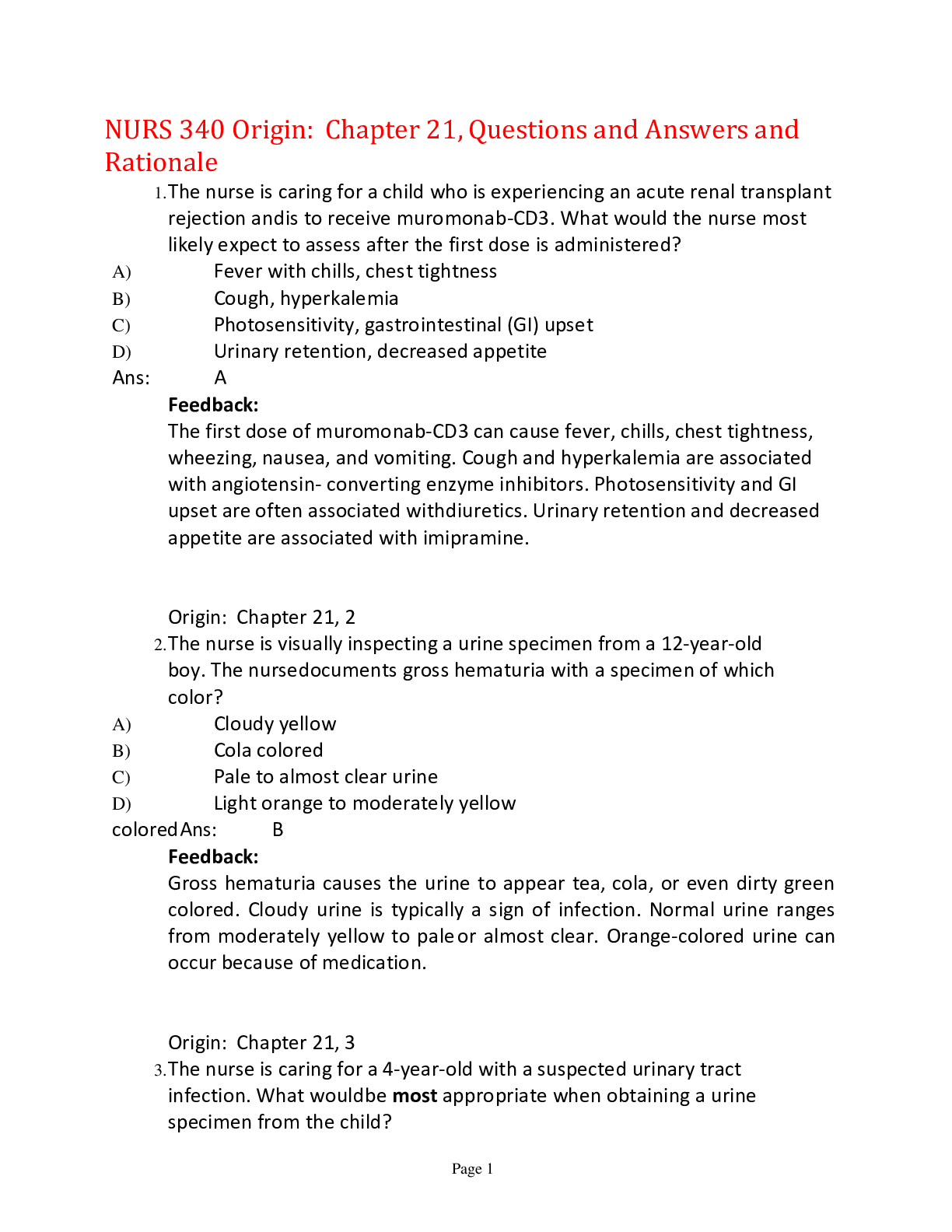
Buy this document to get the full access instantly
Instant Download Access after purchase
Add to cartInstant download
Reviews( 0 )
Document information
Connected school, study & course
About the document
Uploaded On
Feb 01, 2023
Number of pages
21
Written in
Additional information
This document has been written for:
Uploaded
Feb 01, 2023
Downloads
0
Views
45










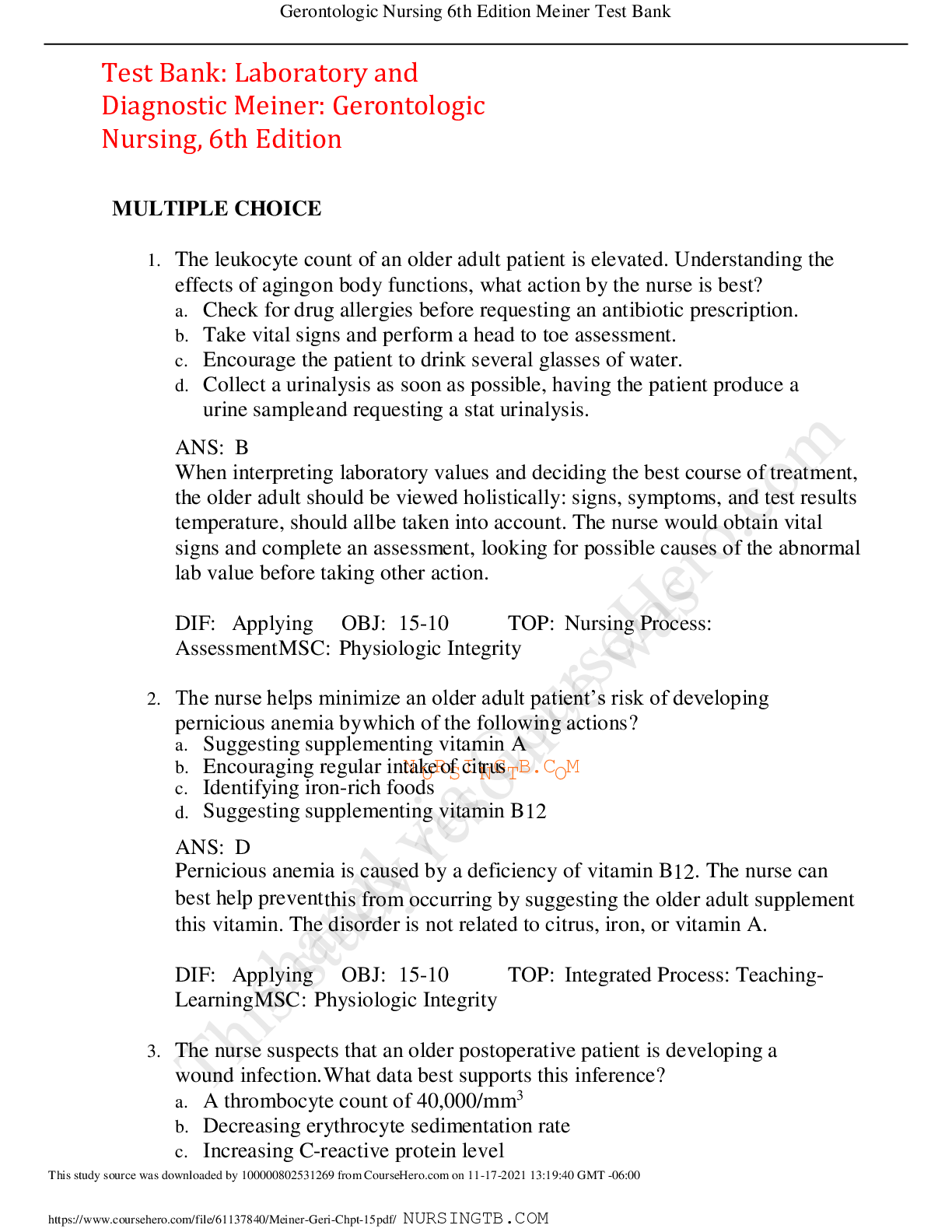


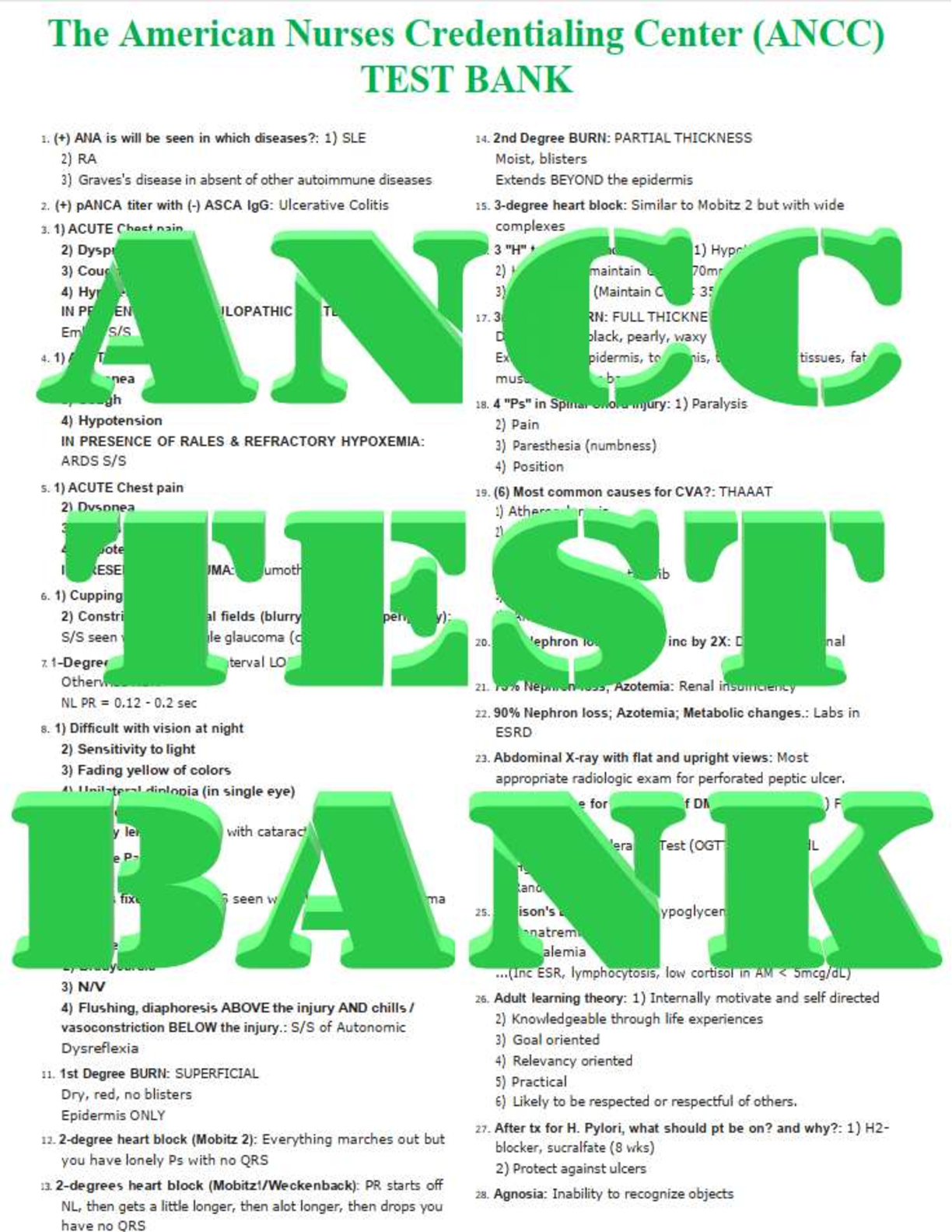
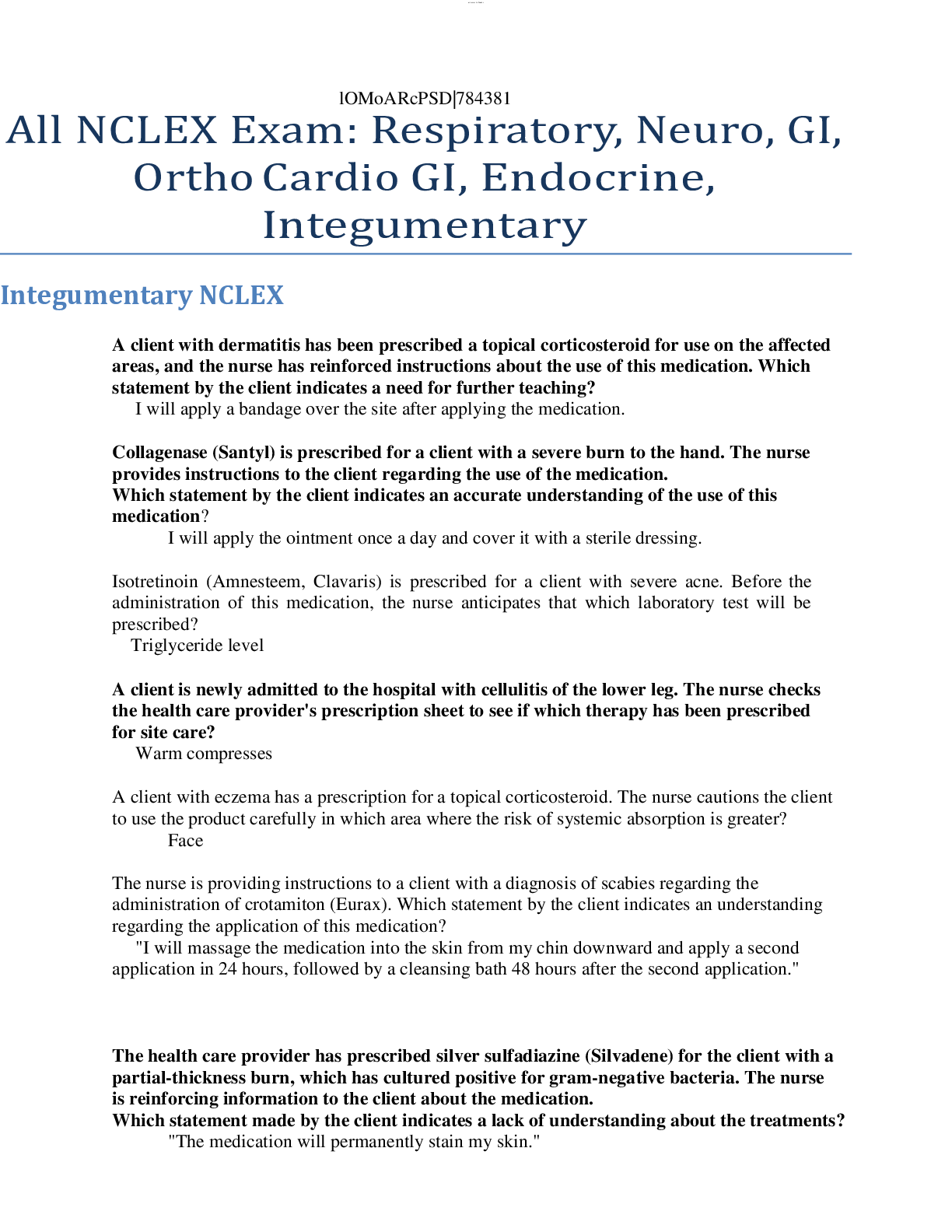

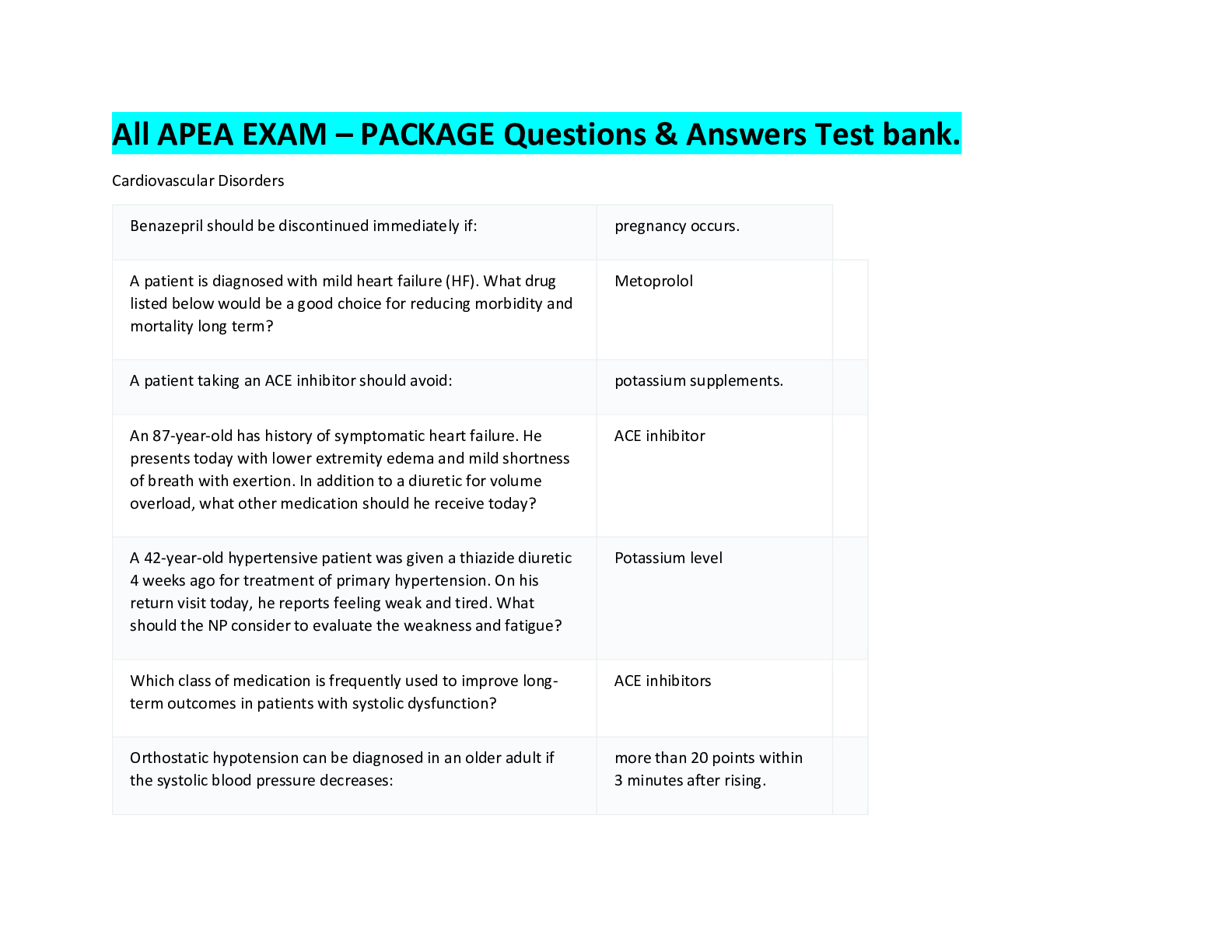


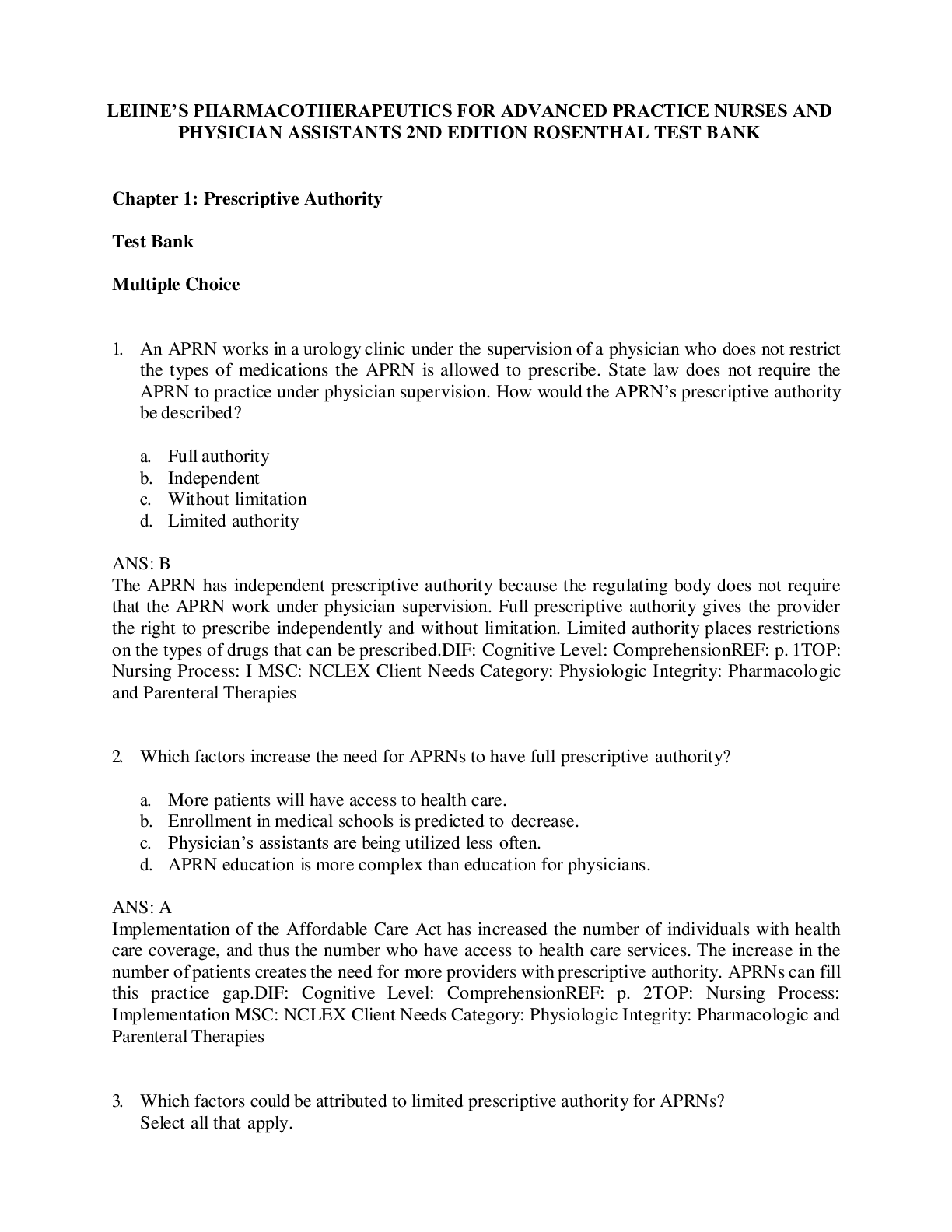
.png)

.png)


